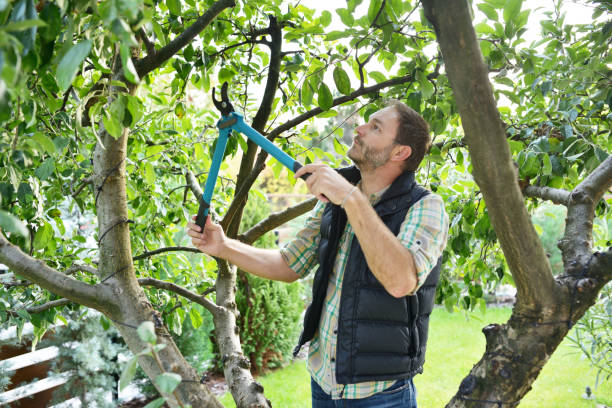Planting Trees Benefits Are Plentiful
What are the benefits of planting trees for the environment
Trees are more than just power plants that provide shade and homes for squirrels. They can prove to be beneficial in multiple ways.
Trees help prevent soil erosion by trapping the sediment of water so it doesn’t enter waterways, making flooding less likely near tree-lined coasts. They also improve air quality by absorbing carbon dioxide and other pollutants and releasing fresh oxygen. Trees help to cool the air and reduce the effect of human-induced climate change by regulating local climates and microclimates. There are studies available which have been conducted by the Aboriculture Australia.
Trees provide a habitat for hundreds and thousands of organisms and thus serve as an important part of many food chains. They also provide several environmental benefits. The amount of organic matter produced by one tree can take years to decompose.

What are the 10 benefits of planting trees?
According to Arboriculture Australia Trees provide a wide range of benefits. They improve air and water quality, reduce soil erosion, and offer food and shelter for wildlife. Trees also add to beauty of areas by providing shade and visual interest for a variety of locations in Australia.
Unexpected Benefits of Planting Trees: A Tree Can Be Worth $60,000
A mature tree offers all kinds of benefits, not just the shade it provides. New research says that benefits of a tree can be worth up to $60,000.
Trees Reduce Air Pollution
Tree plantings reduce air pollution by absorbing carbon dioxide and releasing oxygen into the atmosphere. They also absorb pollutants like soot and smog produced by cars and industrial processes which results in clear, clean air. Which is another example of the environmental benefits of planting trees benefits. In one year an acre of mature trees can provide enough oxygen for 18 people. Average temperatures in Los Angeles have risen 6°F in the last 50 years as tree coverage has declined and the number of heat-absorbing roads and buildings has increased. Trees cool the city by up to 10°F, by shading our homes and streets, breaking up urban “heat islands” and releasing water vapor into the air through their leaves.
Trees Reduce Noise Pollution
Trees reduce noise pollution by deadening sounds produced by cars and trains. They also absorb the sound of wind whistling past buildings which results in a calmer environment for people to live in.
Planting Trees Provides Food for Wildlife
Planting trees provides food for wildlife in Australia. Different trees have different kinds of berries, nuts, fruits and seeds that are eaten by birds, deer, rabbits, squirrels and other animals. In their natural habitat they can provide enourmous benefit to wildlife particularly when it comes to mature trees. Many birds thrive in the many environmental benefits provided through tree coverage. When done well, tree planting is recognised as one of the most engaging, environmentally friendly activities that people can take part in to better the planet.
Trees Reduce Soil Erosion
Trees reduce soil erosion by absorbing heavy rains and providing a canopy for upper story power plants which reduces water runoff. They also slow the flow of water across the surface of the ground which allows soil to settle and prevents flooding.

Trees Reduce Storm Water Runoff
Trees reduce storm water runoff by absorbing large quantities of rainwater before it hits the ground. This reduces water pollution from being carried into local waterways.
Planting Trees is a Great Form of Exercise
Planting trees is a great form of exercise. It provides low impact exercise like bending at the knees and using lower back muscles. Planting trees can also be combined with other forms of aerobic exercise like jogging or biking, which makes it even more beneficial. Its always to a pleasure to take a stroll through a beautiful tree lined street in your local neigborhood.
Planting Trees Creates Shade to Cool Down In
Large trees provide shade to cool down in on hot summer days. The shade that is created by trees provide relief from the sun and reduces the temperature of an area. The can benefit an entire community by providing shade particularly in the warmer climate areas.
Planting Trees Makes Property Appreciate
Trees make property appreciate in value which means they have economic benefits. They increase privacy, increase green spaces, decrease noise pollution, absorb storm water runoff, slow water runoff and reduce soil erosion which results in decreased maintenance costs like mowing or repaving driveways. Which also leads to improved mental health and reducing stress levels for the entire community creating a better future. So its more than just property values and applies to young people and old.
Planting Trees Help Fight Global Warming
Planting trees helps fight global warming because trees absorb greenhouse gases like carbon dioxide, which contribute to the greenhouse effect and contribute to global warming. Planting more trees in Australia is one of the easiest ways to slow down global warming for everyone affected by it. They are incredibly efficient to reduce carbon dioxide.
If you want to plant a tree, you can search for local places to plant trees in your area at TreePeople.org
As Arborists, we need to know what our actions are doing to the environment and how it will affect people. We also need to look into the unintended consequences of our work, like air pollution or noise pollution created by new buildings that aren’t planned with trees in mind.
We need to keep this information in mind so that we can make sure trees are planted the right way and the benefits they provide are maximized for everyone involved.
Why is planting important?
Planting is important because it provides the best possible habitat for wildlife and regulates water flow, sedimentation and erosion.
Why is planting important?
1) Planting is important because it provides the best possible habitat for wildlife.
2) Planting provides highly important feeding, nesting and cover areas for wildlife.
3) Planting regulates water flow, sedimentation and erosion in waterways.
4) Often times planting can reduce flood risks.
5) It also helps to reduce soil erosion in the local community.
Planting trees in Ipswich QLD is important because it provides the best possible habitat for wildlife and regulates water flow, sedimentation and erosion.
Although simple to do, planting has shown massive benefits in areas where projects are needed or already implemented. It can be used to plan wetlands which provides the best possible feeding grounds for many types of animals in the local community. Fossil fuels also increase carbon monoxide levels which makes it important to fight climate change.
Why is tree planting important for the environment?
Trees provide food and many important other things for the environment. The overall environmental benefits are astounding. They can provide an actual place for animals to live, they provide shade which cools down the area underneath them and they absorb carbon dioxide which is a greenhouse gas that causes climate change.
Both young trees and large trees are beneficial to the environment in other ways as well, however this article will focus on their positive impact on climate change. Tree maintenance also creates a sustainable green infrastructure which increases green space and reduces excess carbon dioxide.
The Earth’s atmosphere is made up of greenhouse gases such as carbon dioxide and methane, among others such as water vapour. Greenhouse gases is part of our vital habitat and can absorb heat from the sun and prevent it from going back into space which in turn keeps our earth warm. However too many greenhouse gases in the atmosphere can cause a disruption to the natural greenhouse gases which results in too much heat being held inside. This leads to climate change, or global warming.
The best way to combat the problem of greenhouse gas emissions is by planting trees since they absorb carbon dioxide from the atmosphere which causes them to grow. As the trees grow, they are able to absorb even more carbon dioxide which helps to reduce the carbon dioxide concentration in the atmosphere which in turn slows down climate change.
Trees are able to absorb carbon dioxide through what is called photosynthesis. During photosynthesis, trees use sunlight and water to produce leaves, stems and roots that help them grow while also absorbing carbon dioxide from the air around them, hence why forests are sometimes referred to as the lungs of the planet.
Planting trees is also beneficial because they provide homes for certain animals and can be used as natural windbreaks which slows down strong winds that come in through the front door, so to speak. It can also help reduce soil erosion because it holds onto soil better than regular ground cover.
Trees are truly amazing and they are important for the environment.
Which Tree Species are Native to Australia?
Native and indigenous tree species refer to those that first grew naturally on the Australian continent and were present before European settlement. A number of these native species are very rare, as they have been decimated by land clearing, agricultural development and fire control.
The diversity of Australia’s vegetation is as distinctive as its animals and climate; it ranges from lush rainforest to desert-like conditions, and from plant life found nowhere else on Earth, to temperate zones that are extremely similar to the tree types found in Europe.
The native flora has adapted over time through evolution or adaptation to environmental conditions like drought or high temperatures. The area of origin for many of Australia’s cultivated plants is unknown simply because
National Tree – planting – urban environments – environment – Benefit – Health Benefits – benefits – area – grant – Agriculture – economic – social – homes – Social
The National Tree Week planting ceremony also provided an opportunity for the Australian Government to highlight the health benefits of trees in urban environments. Trees provide a habitat for wildlife, promote biodiversity, and provide shade during hot summer months, while reducing air polluting chemicals such as carbon dioxide and ozone.
Australia’s trees contribute to water conservation and help with soil erosion prevention. The use of native species rather than exotic plantings is encouraged because they are more resistant to insects and diseases. Native tree species also offer other benefits such as: economic (timber production), environmental (absorption of atmospheric carbon dioxide), social (housing) and cultural (spiritual). The National Tree Week provided a grant for $80,000 for projects that involve raising awareness about tree health the benefits to the environment.


